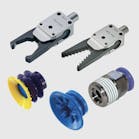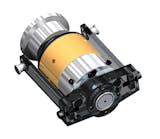Hesta Blasformtechnik GmbH & Co. KG, Schwäbisch Gmünd, Germany, is introducing three new all-electric blow molding machines that target the demand for industrial packaging.
The company presented details about the three at the 34th annual Blow Molding Conference held Oct. 8-10 in Pittsburgh. Sponsored by the Society of Plastics Engineers, the event represented the first time the company has displayed literature about the machines at a trade conference. The company is now marketing the three new models and will build the first machine after it completes a sale.
Hesta's existing blow-molding machines primarily serve the medical and the consumer packaging fields. The new machines are larger and have the ability to accommodate larger molds for the manufacture of drums and large containers for industrial customers.
"These customers have a demand for bigger packages like 20- or 30-liter jerrycans," said Thorsten Bung, Hesta's sales director. "We would like to serve them with more of our Hesta equipment rather than having them buy competitive machinery. That was a strategic decision to bring our technology, innovations and advantages into this field of the industry."
HESTA700J
The largest of the three new machines is the Hesta700J, which is a double-station blow molder capable of making as many as two 30-liter containers per cycle.
It is a modification of the existing Hesta700, a double-station blow molder, which can manufacture containers with capacities of up to 5 liters on multi-cavity molds.
The Hesta700J has a slightly larger footprint and a larger closing unit with higher tonnage, although both the 700 and the 700J have a linear mold stroke of 700mm, or about 27.5 inches.
The new Hesta700J has a width of about 12.7 feet, a length of 11.5 feet and a depth of 20.3 feet.
It can accommodate molds nearly 27 inches wide, 27.6 inches long and 9.8 inches thick.
It has a clamping force of about 45 tons.
HESYA490J
The new Hesta490J is a double-station blow molder capable of manufacturing two containers with capacities of up to 10 liters per cycle.
The new machine is an adaptation of the existing Hesta490, which is capable of manufacturing containers of up to 5 liters on single-cavity molds, one on each side of the double station.
The 490J is about 8.9 feet wide, 11.8 feet long and 17.7 feet deep.
It can accommodate mold widths of about 18.9 inches, lengths of 23.6 inches and thicknesses of 9.8 inches.
It has a clamping force of about 28 tons.
Hesta460J
The new Hesta460J single-station blow molding machine is capable of producing one 10-liter container per cycle. That's twice the size of the container that the Hesta460 produces every cycle.
The new machine is about 7.3 feet wide, 11.2 feet long and 15.7 feet deep.
It accommodates molds up to about 18.9 inches wide, 23.6 inches long, and 9.8 inches thick. It has a clamping force of about 22 tons.
The new J model series, while including larger closing units and encompassing a larger footprint, incorporate extruder sections identical to their comparable consumer packaging blow-molding models, which improves standardization across the machine models, Bung said.
While Hesta sells both all-electric models and hydraulic models, the electric models are increasingly popular, Bung said. One of the main reasons is because all-electric machines on average use 50 percent less electricity than comparable hydraulic versions, he said.
The new J series is all-electric.
Jackson Machinery is Hesta's representative in the U.S. and Canada.
Bruce Geiselman, senior staff reporter
Contact:
Jackson Machinery Inc. Port Washington, Wis., 262-284-1066,
Bruce Geiselman | Senior Staff Reporter
Senior Staff Reporter Bruce Geiselman covers extrusion, blow molding, additive manufacturing, automation and end markets including automotive and packaging. He also writes features, including In Other Words and Problem Solved, for Plastics Machinery & Manufacturing, Plastics Recycling and The Journal of Blow Molding. He has extensive experience in daily and magazine journalism.






